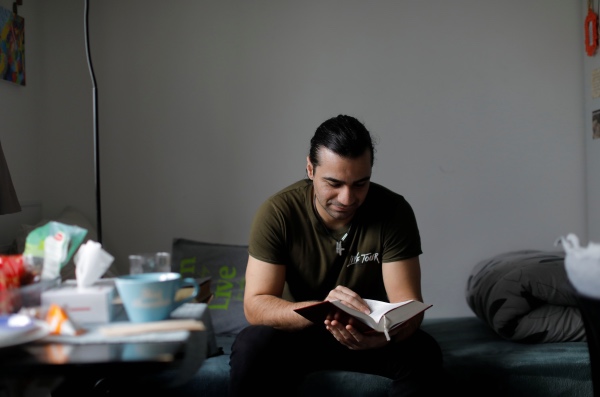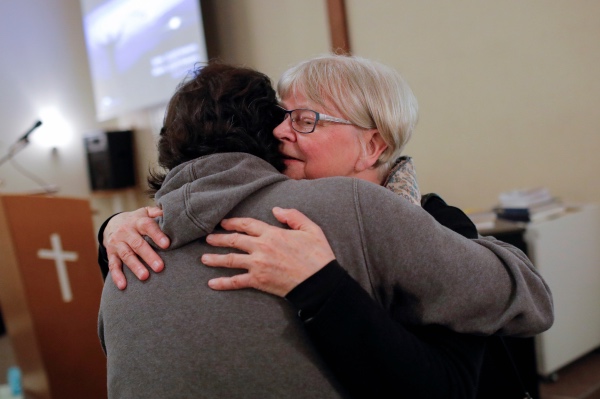Copenhagen, Denmark
Reuters
When Ali Adnan, 27, fled his home in the Iraqi capital of Baghdad in 2015 and arrived in Denmark, a local Danish family took him in and helped him gain his footing in a country he knew very little about.
Now, stuck behind iron gates in one of two departure centres for rejected asylum seekers in Denmark, he feels the reality of political changes sweeping through the Nordic country, and feels his chances of a successful appeal are slim.

Daniel Christensen, 27, from Iraq, reads his Bible in his room at Kaershovedgaard, a former prison and now a departure centre for rejected asylum seekers where he has been a resident since March, 2018, in Jutland, Denmark (taken on 25th March). Christensen used to be called Ali Adnan but prefers to be called Daniel Christensen since converting to Christianity. PICTURE: Reuters/Andrew Kelly
Ahead of a general election on 5th June, both major parties – the left wing Social Democrats and the centre-right Liberal Party, currently in coalition with the Conservatives and the Liberal Alliance, have pledged to continue Denmark’s tough stance on immigration.
“I didn’t know how tough it would be to get asylum in Denmark. But when you’re fleeing, you do not think about that, you just want to go to a safe country,” says Adnan, who prefers to be called Daniel Christensen since converting to Christianity. He said he chose to come to Denmark as his brother lives in the country.
His asylum case was rejected due to a lack of proof of his being in danger in his native country.
The latest available data from the Danish Ministry of Immigration showed that in 2017 35 per cent of asylum seekers were granted asylum, down from 72 per cent and 85 per cent in 2016 and 2015, respectively.
The number of asylum seekers peaked in 2015 at over 21,000 and dropped to 3,500 in 2017, as a result of Denmark’s tougher laws.
Danes, famed for their ‘hygge’ – a word roughly meaning “cosiness” – and for being among the happiest people in the world, according to multiple surveys, were long known for their progressive laws.
But now they are seen as taking the harshest line on immigration within the historically tolerant Nordic region. The views of the public and the state hardened from 2015 with the arrival of large groups of refugees from conflicts in the Middle East.
Similar changes in public attitude have led to tougher laws across the European Union, and moves to drastically reduce the number of refugees reaching the bloc in the first place.
Kaershovedgaard, as the departure centre is called, is nestled in fields, by a small river. It has iron gates and a high steel fence, and houses around 250 residents. The nearest town is more than five kilometres away with no public transport.
A few of the residents have been housed here since March, 2016, when it was established. No-one knows when they will leave.
Some hope for peace and political change at home, so they can pre-empt Danish authorities and return voluntarily. Others hope they can convince Denmark to reverse its decision and grant them asylum.
What makes the return process so lengthy and uncertain is that often home countries refuse to accept people back, refuse to issue them a passport or question their nationality.
“The authorities do not believe our stories, but how should we prove them? I cannot ask those who want to kill me for a piece of paper with a confirmation,” Christensen says.

Retired pastor Betty From Jensen embraces Houman Zahedi, 31 from Iran, who is a three-year resident of Kaershovedgaard, at the end of a Bible cafe meet-up that Jensen helps organise for residents of Kaershovedgaard in the town of Bording in Jutland, Denmark, on 28th March. Kaershovedgaard is a former prison and now a departure centre for rejected asylum seekers. PICTURE: Reuters/Andrew Kelly
Yasaman Paknejad, 36, came to Denmark from Iran to study. She says she is a refugee based on the political situation in Iran, but her asylum case was rejected.
“I have no freedom in here, and it is breaking me down mentally. Regular prisoners know when they will be set free, so this is far worse than being in prison.”
Yasaman understands that Denmark doesn’t have the capacity to grant asylum to all applicants. But the uncertainty of not knowing when she will be sent back to Iran is a torment.
“We are stuck, wasting our best years and our lives.”
According to European Union rules, an asylum seeker can only have their case heard in one European country.
Residents are not allowed to work, receive no social benefits, share small rooms, eat at fixed times in a canteen and are not allowed to cook their own food. They may leave the centre during the day but are required to spend every night there and must report by fingerprint every 72 hours.
“You can’t just pick and choose in Denmark. That is why we need to put pressure on these people to take responsibility and return home. They are not entitled to be here,” Danish minister of immigration and integration Inger Stojberg told Berlingske newspaper in January referring to the departure centers.
Hoshang Rostami, 25, is one of the many Iranian refugees in Kaershovedgaard. In his four years in Denmark, authorities have housed him in five different centers.
He says he feels distrusted by Danish authorities, who have doubted he lost part of his leg due to a landmine accident.
“They told me my papers of imprisonment and political activities in Iran were fake.”






